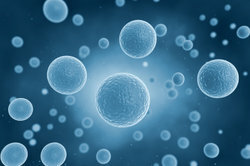Cell division simply explained for laypeople
Cells multiply through cell division. Tissue growth and renewal are based on it. Aging processes are understood as the decline in cell division.

Basics of cell division
- There are two different types of cell division: mitosis and meiosis.
- Mitosis is the normal cell division that takes place during growth, regeneration and healing processes.
- Meiosis, the so-called reduction division, only takes place when the germ cells (egg and sperm cells) are formed.
- The human cell has 23 pairs of chromosomes in the nucleus, which contain the genetic material in the form of DNA. One of the chromosomes in a pair comes from the mother, the other from the father; the nucleus contains 46 chromosomes.
Process of mitosis
- The phase between two cell divisions is the so-called interphase. In this phase, the chromosomes are doubled.
- During cell division, all duplicated pairs of chromosomes migrate to the center of the cell and line up there.
- A spindle apparatus forms at both poles of the cell. Connections to the individual chromosome pairs are formed from this spindle apparatus.
- The chromosome pairs are drawn to the respective pole by the spindle apparatus.
- A partition is formed in the middle of the cell.
- The cell divides into two identical cells, each of which contains 23 pairs of chromosomes.
Mitosis takes place all the time in living organisms. It ensures that in two ...
Course of meiosis
- Meiosis takes place in the primordial germ cells, i.e. in the stem egg cells in the ovary and the stem sperm cells in the testes.
- In principle, steps 1 to 6 are the same as for mitosis.
- This is followed by another division step in which the two daughter cells divide again and the two chromosomes of the pairs are also separated.
- As a result of a meiosis, four cells emerge from each primordial germ cell, which contain only a single set of chromosomes, i.e. 23 chromosomes.
How helpful do you find this article?
The content of the pages of www.helpster.de was created with the greatest care and to the best of our knowledge and belief. However, no guarantee can be given for the correctness and completeness. For this reason, any liability for possible damage in connection with the use of the information offered is excluded. Information and articles must under no circumstances be viewed as a substitute for professional advice and / or treatment by trained and recognized doctors. The content of www.helpster.de cannot and must not be used to make independent diagnoses or to start treatments.


